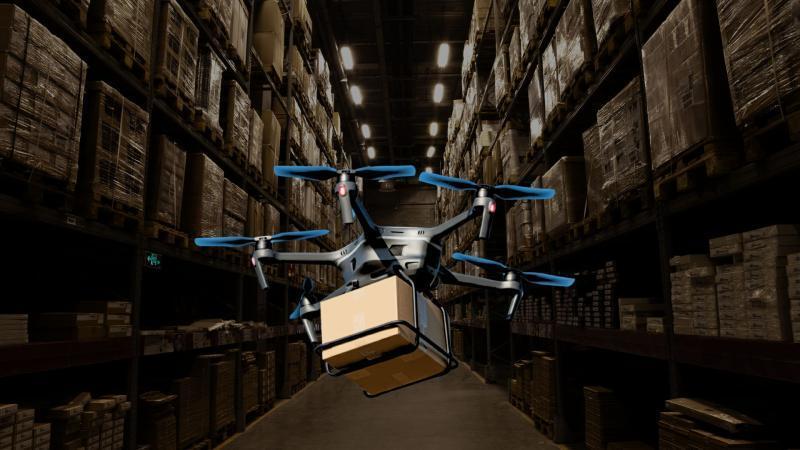
New Tech Optimises Drone Fleets for Faster, Greener Deliveries
The world is witnessing a revolution in the way packages are delivered. With the rapid growth of e-commerce and the increasing demand for faster and more sustainable delivery options, innovative technologies are being developed to tackle the logistics challenge. One such breakthrough is the optimisation of drone fleets, which could significantly reduce delivery times while minimizing the environmental impact.
The “Drone Warehouse Problem” refers to the challenge of efficiently managing a fleet of drones, each with its unique characteristics, to ensure timely and cost-effective delivery of packages. This problem has been a significant hurdle in the adoption of drone delivery technology, particularly for large-scale logistics operations. Fortunately, researchers have made a significant breakthrough in addressing this issue, and the results are promising.
A team of experts from various institutions has developed a novel algorithm that tackles the Drone Warehouse Problem, enabling warehouses to efficiently manage varied drone fleets. This innovation has the potential to transform the last-mile delivery landscape, making it faster, greener, and more scalable.
The Current State of Drone Delivery
Drone delivery technology has made significant progress in recent years, with companies like Amazon, UPS, and DHL testing and implementing drone-based delivery systems. However, the lack of efficient management of drone fleets has hindered widespread adoption. Current systems often rely on manual scheduling, which can lead to inefficiencies, delays, and increased costs.
The limitations of traditional drone delivery systems are multifaceted. For instance, drones are often used in a single-asset configuration, where a single drone is assigned to a specific delivery route. This approach can lead to underutilization of resources, as drones may not always be fully utilized, resulting in increased costs and extended delivery times.
Furthermore, the environmental impact of traditional delivery methods is significant. According to a study by the United States Environmental Protection Agency (EPA), transportation accounts for nearly 27% of the country’s greenhouse gas emissions. With the increasing demand for faster and more sustainable delivery options, it is crucial to develop innovative solutions that reduce the environmental footprint of logistics operations.
Optimizing Drone Fleets with Novel Algorithm
The researchers behind the novel algorithm have developed a sophisticated system that addresses the Drone Warehouse Problem by optimizing drone fleet management. The algorithm, known as the “Drone Fleet Optimization (DFO) algorithm,” uses advanced machine learning techniques to schedule drone flights in real-time, ensuring that drones are utilized efficiently and effectively.
The DFO algorithm takes into account various factors, including drone speed, capacity, and range, as well as weather conditions, air traffic, and package priorities. By considering these variables, the algorithm generates an optimal flight plan for each drone, ensuring that packages are delivered quickly and reliably while minimizing fuel consumption and reducing emissions.
Benefits of Optimized Drone Fleets
The benefits of optimized drone fleets are numerous. By streamlining drone delivery operations, warehouses can:
- Reduce Delivery Times: With optimized drone fleets, packages can be delivered faster and more efficiently, reducing the overall delivery time.
- Minimize Environmental Impact: By reducing fuel consumption and emissions, optimized drone fleets can significantly minimize the environmental impact of logistics operations.
- Increase Scalability: Optimized drone fleets can handle increased demand for delivery services, making it an ideal solution for e-commerce companies and logistics providers.
- Improve Resource Utilization: By optimizing drone utilization, warehouses can reduce costs and increase efficiency, resulting in improved resource utilization.
Real-World Applications
The potential applications of optimized drone fleets are vast. In the e-commerce industry, optimized drone delivery can revolutionize the last-mile delivery process, enabling companies to provide faster and more sustainable delivery options to customers. Additionally, the technology can be applied in various industries, such as healthcare, where drones can be used to transport organs for transplantation or medical supplies to remote areas.
Conclusion
The development of the DFO algorithm marks a significant breakthrough in the field of drone delivery technology. By optimizing drone fleets, warehouses can reduce delivery times, minimize environmental impact, and increase scalability. As the demand for faster and more sustainable delivery options continues to grow, innovative technologies like the DFO algorithm will play a crucial role in shaping the future of logistics.
Source: Novel Algorithm Tackles Drone Warehouse Problem for Faster Deliveries (https://researchmatters.in/news/novel-algorithm-tackles-drone-warehouse-problem-faster-deliveries)






